The blue racer snake is one of the few species of blue snakes in the world.
This species is scientifically known as the Coluber constrictor foxii. It is a subspecies of the well-known North American racer.
Blues are one of the most recognizable racer sakes because of their bright scales. They have a white underbelly and metallic scales that range in color from gray-green to bright cyan.
Like most racers the blue can be flighty and prone to biting. This makes them a poor choice for new snake keepers.
Despite the controversies associated with this species it is a desired pet.
If you are an experienced enthusiast and want to learn more about this attractive blue snake then keep reading…
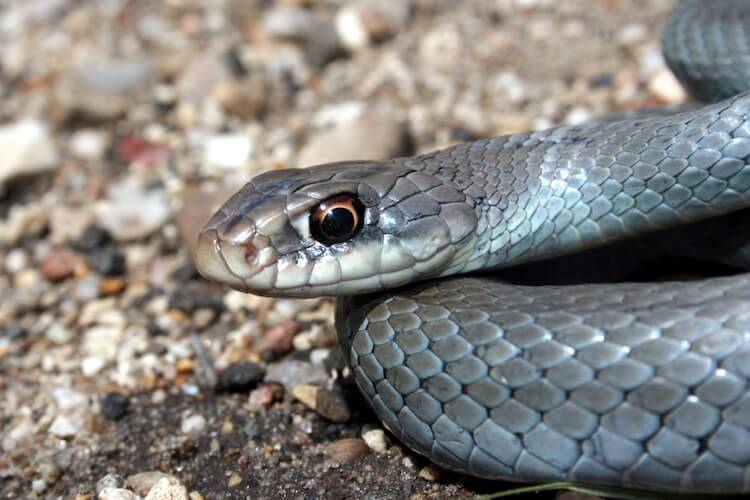
Blue Racer Snake Profile
The Blue Racer Snake is one of 11 North American racer subspecies. They are part of the Colubridae family – the largest snake family in the world.
Blue racers are unique for their blue coloration and distinctive black mask.
They adapt to a wide variety of habitats and climates. In the United States they can be found near the Great Lakes, from Minnesota to Southwestern Ontario and Indiana.
Their range in Canada is limited to a small population on Pelee Island.
Sadly their wild population is decreasing due to habitat loss, construction and human activity. This has led the snake to be listed as endangered in Canada. Currently they are not considered endangered in the United States.
Blue racer snakes are named after their color and high metabolism.
Their high metabolism lets them slither at speeds of up to 4 miles per hour!
When threatened blue racers will first try to outrun their attacker.
If that fails they may vibrate their tail against vegetation to make a buzzing noise and strike repeatedly. Although nonvenomous they can cause a painful bite and so should be approached cautiously in the wild.
What We Like About Blue Racers
Pros
- Attractive and rare blue coloration.
- Adapt well to cooler climates.
- Intelligent and inquisitive.
Cons
- Aggressive and wary of humans.
- Large tank requirements.
What Does A Blue Racer Snake Look Like?
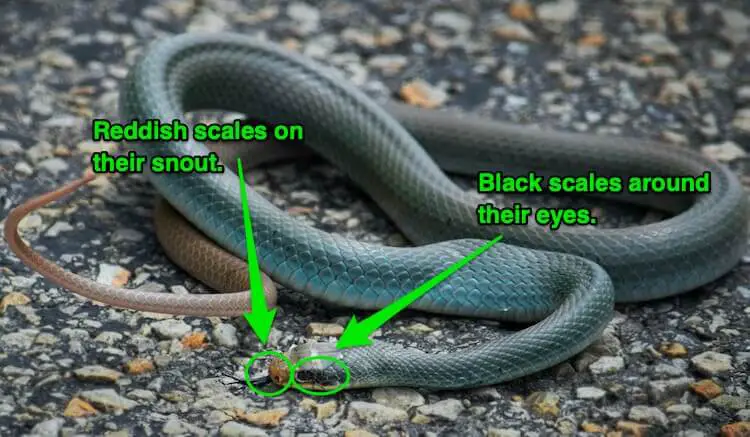
The blue racer snake is one of the most attractive and easily recognizable racers. This is because of its bright blue scales. They grow to 36 to 60 inches in size and are easily identified by their metallic gray-green scales.
Two key features unique to the blue racer are:
- The black scales around their eyes that form a mask.
- The reddish scales on their snouts.
Some blues are a darker gray color and can be harder to distinguish from other subspecies such as the southern black racer (pictured below).
All 11 subspecies of racer snake have varying colors and patterns.
The buttermilk racer (Coluber constrictor anthicus) is an unusual snake with a checkerboard pattern on its back. The eastern yellowbelly racer (Coluber constrictor flaviventris) is coffee-colored with a yellow underbelly.
Blue Racer Size
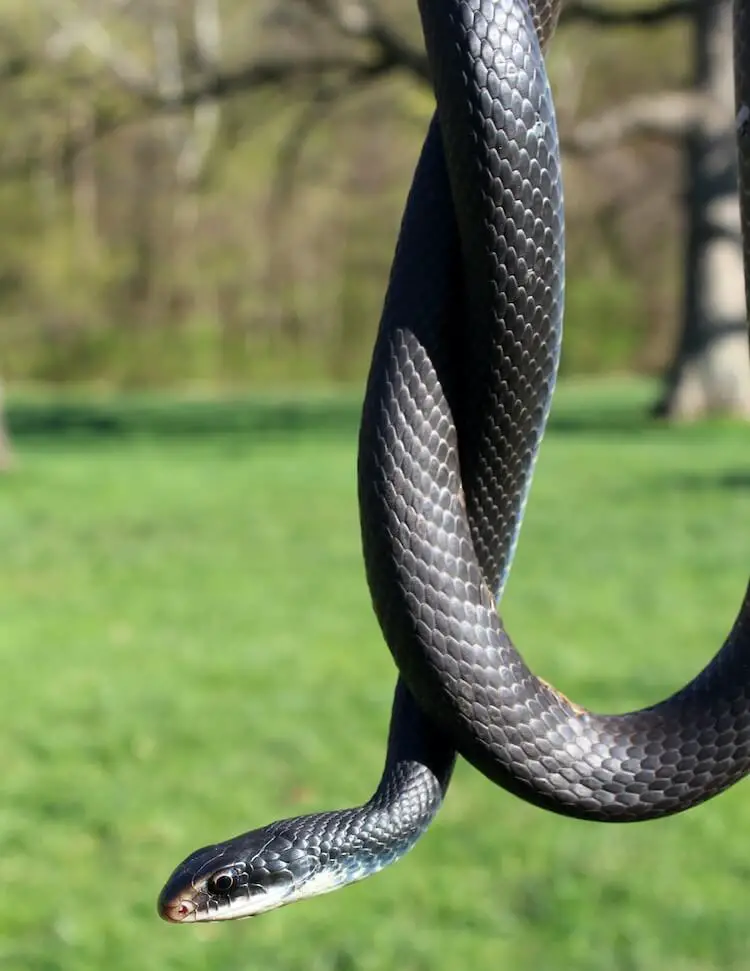
Adult blue racers range in size from 36 to 60 inches.
There is little size variation between males and females. Both sexes are slender snakes and are not particularly heavy-bodied like a Western Hognose.
Hatchlings are generally 7.5 to 15 inches in length (not including their tail).
Juvenile snakes normally double in size over the course of their first year.
Young snakes have a dark blotched pattern on their backs (similar to juvenile rat snakes) which they lose as they reach sexual maturity.
Blue Racer Snake Care Sheet
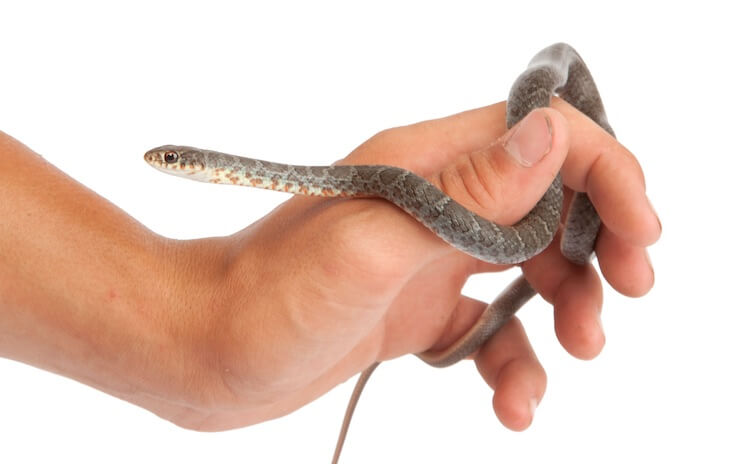
Blue Racer Diet
In the wild blue racer sakes are opportunistic feeders. This means they will happily prey on insects (especially grasshoppers), locusts, birds, small mammals, amphibians, lizards, other snakes and eggs.
Their prey choice and diet change over the course of the year.
This species eats more mammals in the spring and summer and insects in the fall. Juveniles tend to eat more insects due to their smaller size.
Birds and bird eggs represent a smaller portion of their diet because blue racers are not heavy climbers. However, they will eat them if they get the chance!
Blue Racer Snakes in captivity are active hunters.
They should be fed mice (either pinkies or adults) during the day.
Mice should be pre-killed to avoid injury to your snake. Alternatively many snake owners prefer to use frozen-thawed mice. Frozen-thawed mice are widely available and can be stored easily.
For diet variety and stimulation, blue racers can also be fed the occasional grasshopper. But note that grasshoppers are not as convenient to store as mice and should not be their exclusive diet.
Finally, they should have constant access to clean water.
The water bowl should be shallow enough for your blue snake to climb in and out of easily. Racers are not known to soak so their bowl does not need to be large enough for their whole body.
Lifespan & Health
Blue racers can live up to 10 years in the wild and slightly longer in captivity. Males and females live to be about the same age.
Because pet blue racers are usually wild-caught they share many of the same health problems with other wild snakes.
Fungal diseases are commonly found on wild snakes. They show up as crusty lesions or yellow scales around the mouth and sides of a snake.
Parasites like mites and ticks can also be a problem.
Ticks are usually found with their heads buried under a scale. Mites appear as tiny dots moving near a snake’s eyes and nose or in their water bowl. You can also notice mites on your hands when holding an infected snake (they won’t hurt you).
Bacterial diseases can be caused by poor husbandry and dirty bedding. Mouth rot (Ulcerative stomatitis) shows up as sores and pus around a snake’s mouth.
Signs They Are Healthy
- Glossy scales.
- Alert behavior.
- Clear eyes.
- Good appetite.
Sickness Symptoms
- Crusty scales.
- Sluggish behavior.
- Bubbles around the mouth and nose.
- Lack of appetite or weight loss.
Housing Blue Racers
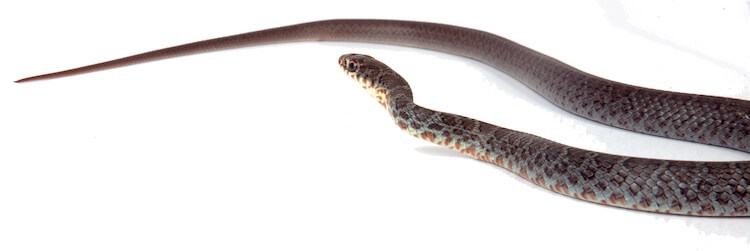
Blue Racer Snakes prefer wide open spaces and habitats such as forests.
Racers have a large home range that is about 0.4 square miles for females and 0.8 square miles for males.
In the cooler months Blue Racers will move to less-covered areas such as abandoned fields to soak up the sun. They can tolerate temperatures as low as 50°F.
In the warmers months they will move into a habitat with more vegetation such as a forest.
Enclosure Set Up
Racers like to have a lot of ground space in captivity. They should have at least enough room to stretch out to their full length and prefer to have more ground space to height.
Because of their speed they should be able to move around their enclosure to avoid stress and boredom.
They like to roam and will need quite a bit more space than a ball python or corn snake. An adult racer should be housed in at least a 100-gallon terrarium:
- Tank Type: glass.
- Tank Size: 100-gallon.
- Lighting: Both UVA and UVB required.
- Substrate: wood shavings.
Blue racers need both a UVA and UVB light to properly metabolize their food. They prefer slightly cooler temperatures than other snakes with a high range ~85°F. An enclosure should have a temperature gradient to allow your snake to self-regulate its body temperature.
Overall tank temperature can be as low as 70°F at night. A ceramic heat bulb can be used if the nighttime temperature is too low.
Racers do not need a specific humidity beyond the regular ambient humidity. However, it can be a good idea to include a humid hide with sphagnum moss when your snake is shedding.
To make your snake comfortable you should try to mimic its natural habitat.
Blue racers can be flighty so it is a good idea to provide multiple hiding places for your snake.
Place lots of decor in their enclosure too. Good examples include: branches, boxes, tunnels and plants (real or fake).
The blue racer is intelligent and will likely explore anything you place in its cage. They are not like a corn snake (i.e. climbing snakes) so expect your racer to be mainly active on the floor of its enclosure.
Substrates can include wood shavings (avoid pine and cedar), coconut fiber or paper towels. Paper towels are more utilitarian but are far easier to keep clean and change.
Loose substrate can be spot-cleaned as needed and should be changed completely every month to avoid diseases.
Typical Behavior

Racer snakes are diurnal so like humans they are most active during the daytime.
Blue racers enjoy basking in open areas to relax. However, this is a species that likes to be on the move and so will not spend much time under substrate or in a hide box.
In the wild this snake will share burrows with other species. Racers will also hibernate with other snakes in rocky crevices and old animal burrows.
In captivity they are not social and should be kept by themselves.
If startled or threatened racers will first try and run away. If their enclosure is too small for them to feel safe they will stand their ground and bite repeatedly. Blue Racer snakes are non-venomous but they have a lot of curved teeth that make for a painful bite.
To avoid bites it is best to start with a young snake in a large cage and get it used to being around people.
Blue racer snakes are aggressive and can strike from a long distance. They do not tolerate being picked up.
In addition to biting, they will musk and twist their bodies around to make themselves difficult to hold.
Confident owners should use a snake hook to manipulate and move their blue snake.
How Fast Is A Blue Racer Snake?
Blue racer snakes are in part named after their speed. They can slither at speeds of up to four miles per hour. They are fast animals and may be hard to catch if they decide to unexpectedly leave their terrarium. Their thin bodies allow them to squeeze into cracks that humans cannot reach.
Where Can You Buy A Blue Racer Snake?
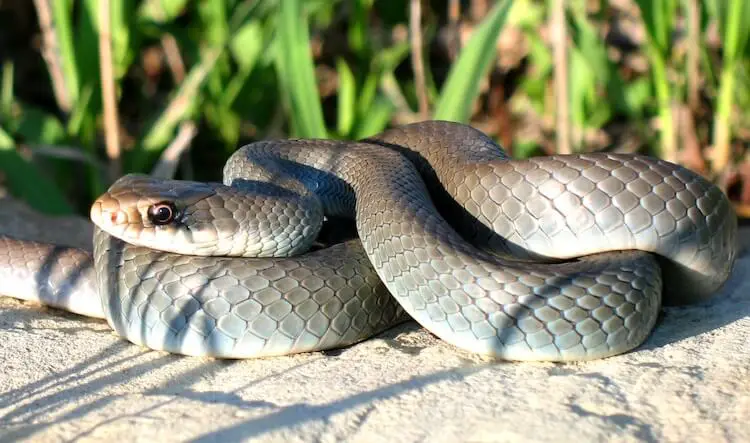
Blue racer snakes are considered endangered in some parts of North America, so they are difficult to find for sale.
They are not common in the pet trade.
Most individuals are wild-caught snakes that are then sold. Due to their declining population it is best to find a captive-bred.
The best place to find captive-bred blues is at a reptile show/expo or from a private breeder.
Make sure the breeder is reputable and their snakes look to be in good health (e.g. alert and well-fed).
It is easier to assess the health of a seller’s snake in person.
You should also check for mites, crusty scales and any other sign of ill health. A thin snake can be a sign of internal parasites – especially if it is wild-caught.
A blue racer will normally cost between $50 – $100. The brightest and bluest individuals are more likely to be sold for a premium price.
Blue Racer Snake Facts
| Common Name | Blue Racer |
|---|---|
| Scientific Name | Coluber constrictor foxii |
| Price | $50 – $100 |
| Size | 5 feet long |
| Lifespan | 10 years |
| Diet | Mice, insects, lizards, eggs |
| Tank Size | 100-gallon |
| Humidity & Temperature | Daytime temperature: 80℉ – 85℉ Humidity: 40% – 50% |
| Popular Alternatives | Black rat snake, corn snake or bull snake |
Summary
The blue racer snake is a fast, attractive non-venomous reptile. Blues grow to 36 to 60 inches in size and are easily identified by their metallic gray-green scales.
These snakes are not picky eaters and will readily eat mice, locusts, lizards and frogs in captivity.
Due to their aggressive nature they are not good snakes for first time owners. They also require a very large enclosure because of their size, activity and speed.
Blue racers are not readily available at most reptile stores.
This racer subspecies is endangered in Canada and is under threat in the rest of its range. It is up to the potential buyer to assess whether or not the appeal of owning this unique animal is worth the harm to their population.
Do you have a captive-bred blue racer? Let us know in the comments.

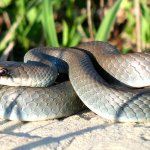
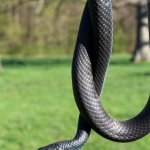
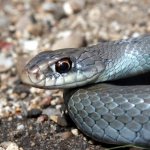
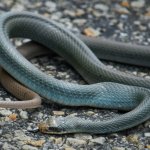
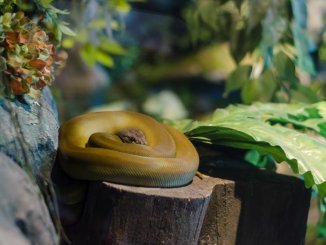
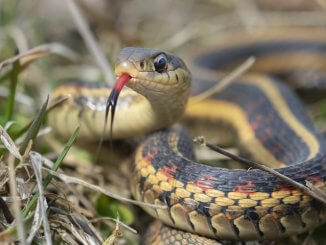
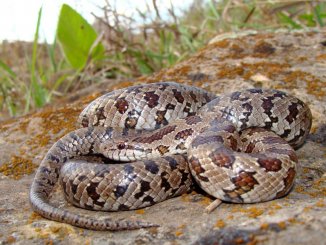

I live in central PA and found a baby Blue Racer I accidentally hit with my mower, but means there are more of them. I did not think they were in PA. Any info or comments would be helpful…would like to see these little guys prosper!
Blue Racers are also naturally in the South Okanagan (eg. Oliver, B.C., Canada) and not just at Point Pelee or Pelee Island in Ontario!
Tell us more! The Canadian government website for wildlife mentions Pelee Island as the last remaining habitat where you can find Blue Racer in the country.